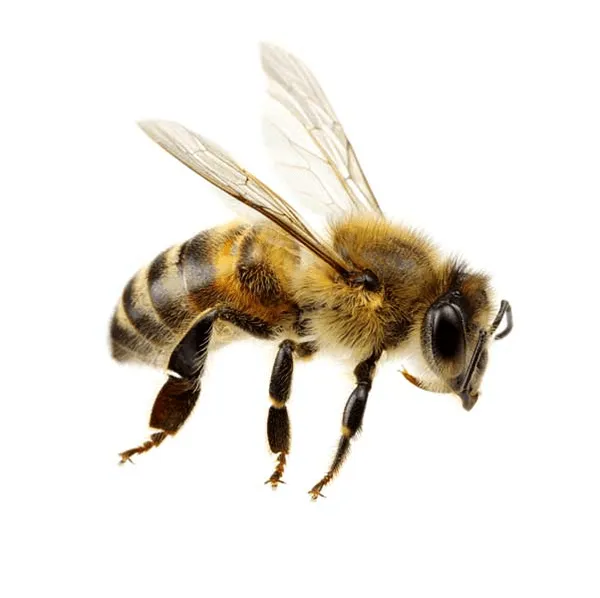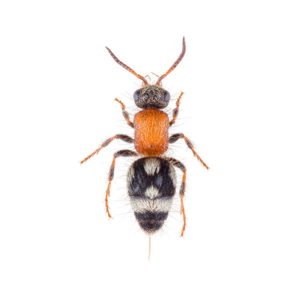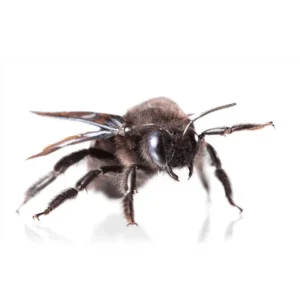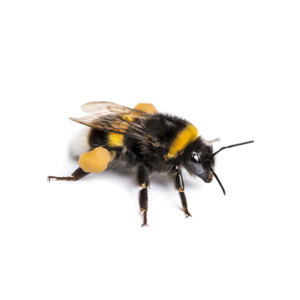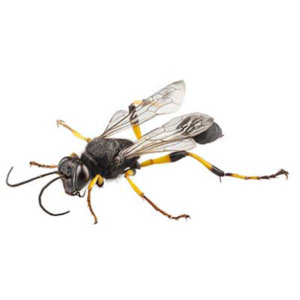Honey Bee Identification
What Do Honey Bees Look Like?
Honey bees are small insects with a distinctive appearance. They have a plump, segmented body covered in fine hairs, with a golden-yellow to brownish coloration. Their bodies are typically striped with bands of alternating black and yellow or orange. Honey bees have four wings that are clear and delicate, along with long antennae and compound eyes. They also have specialized pollen baskets on their hind legs for collecting pollen.
Unsure whether you are dealing with honey bees? We can help you to identify common bee, wasp & hornet species.
Signs of a Honey Bee Infestation
Honey bees often build their nests in tree crevices, but will occasionally build nests in attics or chimneys. Honey bees are most visible in summer and late spring when new queens leave their old colonies along with thousands of workers to build new nests in tree hollows or crevices. At this time, large groups of bees can be seen swarming together to find a new nesting place. It takes a swarm approximately 24 hours to locate a new nesting site. While most swarms are harmless, certain species of bees, like the Africanized honey bee, are extremely aggressive and may attack unprovoked.
Habitat, Diet, Life Cycle & Stings
Where Do Honey Bees Live?
Honey bees live in colonies, typically housed in enclosed structures known as hives. Wild honey bee colonies may nest in tree hollows, rock crevices, or other natural cavities.
Diet of a Honey Bee
The diet of a honey bee varies depending on its life stage. Adult honey bees primarily feed on nectar and pollen obtained from flowers. Nectar serves as their primary source of carbohydrates, providing energy for flight and other activities. Pollen, rich in proteins, vitamins, and minerals, is collected to feed developing larvae and nourish adult bees. Worker bees also produce and consume royal jelly during the first few days of their lives. This nutrient-rich substance is secreted by glands in their heads and is fed to larvae and queen bees, contributing to their development and reproductive capabilities.
Life Cycle of a Honey Bee
The life cycle of a honey bee begins when a queen bee lays eggs in hexagonal cells within the hive. After hatching, the larvae are fed royal jelly by worker bees for a few days before transitioning to a diet of pollen and nectar. Larvae then pupate within their cells, emerging as adult bees after about two weeks. These adult bees become workers, drones, or future queens, depending on their caste and the needs of the colony.
Do Honey Bees Sting?
Honey bees do sting, but can only sting once. Only female workers are capable of stinging and are not likely to sting when foraging for nectar and pollen in the backyard. Bee stings generally happen when these docile bees are provoked or accidentally crushed. The stinger of the honey bee, having barbs, will remain in the skin unless physically removed. The method of removing the stinger, either grasping with fingers, tweezers, or scraping from the skin, is not as important as removing the stinger as quickly as possible.
Are Honey Bees Dangerous?
Honey bees are generally not considered dangerous unless provoked or threatened. They are not aggressive by nature and will usually only sting in self-defense or to protect their hive. When a honey bee stings, it leaves behind its stinger and venom sac, which can continue to release venom. Honey bee stings are quite painful and even life-threatening to a small percentage of people who are allergic to venom. If a honey bee nest is suspected on your property, it is always best to contact a professional bee removal company.
Honey Bee Prevention Tips
To prevent issues with honey bees around your home:
- Seal cracks and openings in walls, roofs, and windows to prevent honey bee entry.
- Keep outdoor food and drinks covered to avoid attracting bees.
- Regularly inspect your property for signs of honey bee activity, such as swarms or nests, and address them promptly.
- Avoid wearing floral or brightly colored clothing when spending time outdoors, as these may attract bees.
- Plant bee-friendly flowers away from high-traffic areas to divert bee activity.
- If you encounter a swarm or nest, keep your distance and contact our wasp and bee pest control experts for safe removal.
Need help with Honey Bees control?
FAQs
Are Honey Bees Aggressive?
Honey bees are generally not aggressive by nature. They are social insects that prioritize the protection of their hive and colony members, rather than seeking out conflict with humans. However, they may become defensive and sting if they perceive a threat to their nest or themselves. Common triggers for honey bee aggression include sudden movements, vibrations, strong odors, or disturbances near their hive.
Are Honey Bees Friendly?
While honey bees are not necessarily “friendly” in the way we might describe a pet, they are generally docile and not aggressive towards humans when left undisturbed. They play a crucial role in pollination and agriculture, and many beekeepers work closely with honey bee colonies without issues. With proper respect and caution, interactions with honey bees can be peaceful and beneficial for both humans and bees.
What Are the 3 Types of Honey Bees?
The three main types of honey bees in a colony are:
- Queen Bee: The queen bee is the reproductive female in the colony. She lays eggs and regulates the activities of the colony.
- Worker Bees: Worker bees are sterile females responsible for various tasks within the colony, such as foraging, nursing the brood, and building and maintaining the hive.
- Drone Bees: Drone bees are male bees whose primary role is to mate with virgin queens from other colonies. They do not have stingers and are solely focused on reproduction.

